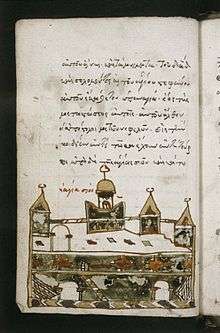Church of Zion, Jerusalem
Church of Zion, Jerusalem, also known as the Church of the Apostles on Mount Zion, refers to the remains of a Roman-era church or synagogue on Mount Zion in Jerusalem that some historians speculate may have belonged to an early Jewish-Christian congregation.

History
The remains of the church or synagogue date back to the 2nd-5th century, when Jerusalem was renamed Aelia Capitolina by the Romans.[1] The reference to such a congregation is from the Bordeaux Pilgrim (c.333), Cyril of Jerusalem (348) and Eucherius of Lyon (440), but in academia the theory originates with Bellarmino Bagatti (1976), who considered that a Jewish Christian synagogue existed in the old "Essene Quarter".[2]
In 1951, archaeologist Jacob Pinkerfeld interpreted the lower parts of the Mount Zion structure known as David's Tomb, as the remains of a synagogue which, he concluded, had later been used as a Jewish-Christian church.[3] Emmanuel Testa's support for Bagatti's view led to the "Bagatti-Testa school", which believes that a surviving Jewish-Christian community existed in Jerusalem, and that many Jewish-Christians returned to Jerusalem after the wars and established themselves on Mount Zion.[4] Bagatti's theory is supported by Bargil Pixner (May 1990 Biblical Archaeology Review[5]) who argues that the 6th-century Madaba Map shows two churches - the Basilica of Hagia Sion and the "Church of the Apostles," the putative Jewish-Christian synagogue of Mount Zion.[6]
The problem with the thesis of Bagatti, Testa, Pinkerfeld and Pixner is that the layers indicate a Crusader structure built on top of Roman layers.[7]
References
- Günter Stemberger Jews and Christians in the Holy Land: Palestine in the fourth century Page 79 - 2000 "A further attempt to locate Jewish Christians in Jerusalem is connected with the Church of Zion. The arguments that have been advanced to date for the idea that in Jerusalem a Gentile Christian congregation, the majority, had its home at the Church of the Holy Sepulchre, while a Jewish Christian congregation centred on Mount Zion,."
- Studia Hierosolymitana in onore del P. Bellarmino Bagatti: Volume 1 Bellarmino Bagatti, Emmanuele Testa, Ignazio Mancini - 1976. However, not the biblical Mount Zion, but rather the "Christian" Mount Zion will be explored in this study. ... B. Bagatti and others think that the "synagogue" referred to must have been a Judeo-Christian one...
- Elizabeth McNamer, Bargil Pixner Jesus and First-Century Christianity in Jerusalem p6 8, 2008 "In 1951, archaeologist Joseph [sic] Pinkerfield found on Mount Zion the remains of a synagogue ... Pinkerfield also found pieces of plaster with graffiti scratched on them that came from the synagogue wall. "
- Joan E. Taylor Christians and the holy places: the myth of Jewish-Christian origins 1993 p1 "According to the Bagatti-Testa school, the Jewish-Christian church was centred in Jerusalem and headed first by Peter ... Many Jewish-Christians then returned to Jerusalem after the war ended and established themselves on Mount Zion."
- Pixner BAR article, May 1990 Archived 2018-03-09 at the Wayback Machine
- James R. Davila The Dead Sea scrolls as background to postbiblical Judaism and ...2003 p66 "Channels of Communication: Essenes in Jerusalem? In a long series of publications since 1976 the Dominican archaeologist Bargil Pixner has been arguing the case for an Essene quarter in Jerusalem located on the southern part of the ..."
- Edwin K. Broadhead Jewish Ways of Following Jesus: Redrawing the Religious Map of ... 2010 p 320 "Finally, Pixner claims that the Madaba map (6th century) indicates that the Byzantine Hagia Sion was built alongside the Church of the Apostles, not over it. A key problem in the theory of Bagatti, Testa, Pinkerfeld, and Pixner is the sequence of layers. If the walls identified by Pinkerfeld are Roman era, one is left with a Crusader structure built directly on top of Roman walls."